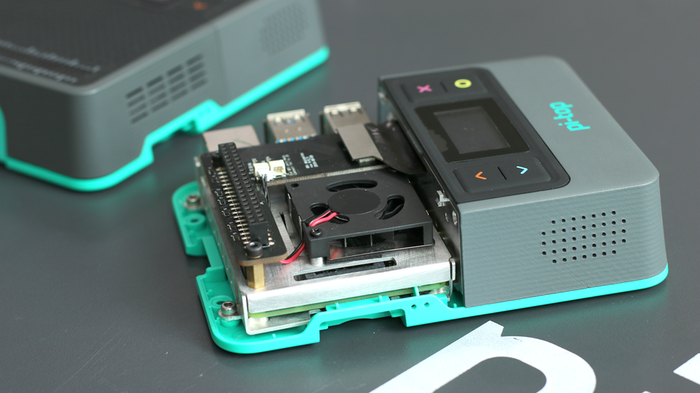The pi-top laptop kits are among the most versatile and intriguing STEM supplies for in-depth learning experiences. We're now up to the pi-top [4]—the fourth version of this mobile, DIY computer and, over time, students have explored numerous ways of building STEM skills from engineering to coding. Students receive all the basic parts they need to build the pi-top computer—something that remains true with the all-new pi-top. The computer comes disassembled with all the necessary components, allowing students to build a computer from scratch. And now, with the Robotics and Electronics Supersets, they can build their own programmable robots and electronics devices, too!
The all-new pi-top [4] laptop.
Starting with the pi-top [4], this revamped DIY device empowers students to design, code, and create with ease. It also helps them focus on exploring key physical computing concepts with a sprinkle of project-based learning along the way. The kit comes with the pi-top [4] processor, a Raspberry Pi 4, a 16GB SD card, a power supply, a display cable, an HDMI adapter, and a USB adapter. With the portable pi-top [4] as the brains of the system and the Raspberry Pi already installed, it's extremely easy and exciting to jump right in to pi-top [4] projects. Plus, the SD card comes with the pi-topOS already loaded.

Once they build the pi-top [4] system, students can explore it independently or combine it with projects they create using the other pi-top kits. If using it without the robotics or electronics components, students can still try programming thanks to the pi-top [4]'s programmable buttons and screen. It also boasts an internal battery that lasts five hours, a heat sink and cooling fan, and a 1-watt loudspeaker. Plus, students can access all of the Raspberry Pi's GPIO pins and ports as well as coding lesson plans to explore with the included Dozens of Foundation content on the pi-top Further platform.
The Robotics Superset.
Next up, we have our new pi-top offerings—starting with the CS and Robotics Kit. This kit is similar in design and intent to the line of pi-top computer kits. Essentially, it comes with all the same pi-top components but also a long list of robotics pieces as well. As you might guess, instead of simply building the pi-top computer, students are also challenged to build their own robot. The CS and Robotics Kit is one of few educational robot solutions we offer that students can engineer themselves—completely from scratch. And, like the pi-top, once they build it, they can incorporate its various components and capabilities in programs and projects.
The real benefits with this kit come as students build their programmable robot models. In addition to the same components that come in the standalone pi-top [4] package, the Robotics Superset also includes a robotics kit of its own. In that kit, there are over 50 aluminum construction pieces for assembling the robot. The robotics kit also comes with 250 rivets, two servo motors, two encoder motors, an ultrasonic sensor, a 720p HD camera, and various other pieces for building a powerful robotics system. Whether they're in the classroom, library, or makerspace, the pi-top Robotics Superset and these real-world components are great for helping students build STEM skills and explore technology, creative thinking, and more.
The Electronics Superset.
Next, we have the pi-top Electronics Superset with the same premise as the other two kits. These projects, however, are geared a bit more towards computer science students, specifically. Even if they're new to computer science, however, the Electronics Superset, its components, and STEM projects are extremely accessible. In creating projects and exploring STEM concepts, students will pick up basic coding principles and physical computing insights. Plus, once they have some experience, they can explore more advanced areas of CS, including robotics, cybersecurity, and artificial intelligence.

Like the Robotics Superset, the Electronics Superset comes with all the pi-top components and an Electronics Kit. The Electronics Kit includes a foundation plate, an ultrasonic sensor, a buzzer, a light sensor, a sound sensor, two potentiometers, six total LED lights, two buttons, and eight connecting cables. Students can control the computer's lights and sounds with the sensors, buttons, and potentiometers with a few lines of code. Best of all, it's a great way to introduce coding for beginners since students don't need any experience at all. They can connect their builds to a monitor, keyboard, and mouse, access the Further library, and explore all the possibilities!
Buying pi-top kits for your school.
As we said, there are now four pi-top kits on our store and you can find each of them below. The fourth of the pi-top offerings is the Robotics & Electronics Superset. As you might guess, it's a combination of the Robotics Superset and Electronics Superset with all the components from each. In combining the various components, students can create more advanced projects based on autonomous driving, prototyping, the IoT, and more. Each SD card is also pre-loaded with the pi-topOS software, so students should have no issues when beginning these experiences. To learn more about the pi-top kits, visit our store or contact our team. And, as always, follow us on Twitter and Instagram for more.



